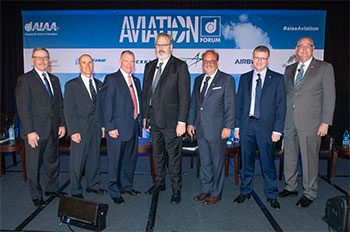Unprecedented Global Partnerships, Collaboration Fuels F-35 Program Written 26 June 2018
Panelists: Moderator Graham Warwick, managing editor, Aviation Week and Space Technology; Eric Branyan, vice president, F-35 Supply Chain Management, Lockheed Martin; Declan Holland, vice president of U.S. business, BAE Systems Inc.; Frank Carus, vice president and F-35 program manager, Northrop Grumman Corp.; Thomas Johns, director, F135 Weapon System Integration, Military Engines, Pratt & Whitney; John Mazur, director of foreign military sales, Joint Strike Fighter Joint Program Office; J.D. McFarlan, vice president, F-35 Test and Verification, Lockheed Martin
by Lawrence Garrett, AIAA Web Editor

AIAA AVIATION Forum, Atlanta, June 26, 2018 – The successful development of the F-35 has required unprecedented worldwide partnerships and extraordinary collaboration between private industry and government, said a panel of industry experts June 26 during the “Reflection on the Partnerships Within the F-35 Enterprise” session at the 2018 AIAA AVIATION Forum in Atlanta.
“I can honestly tell you that in the over 30 years that I’ve been in the business ... certainly the [Joint Strike Fighter] F-35 program is unlike any other program I have worked on,” said Frank Carus, vice president and JSF F-35 program manager at Northrop Grumman.
Carus noted that the different intricacies of the program were incredibly challenging but that one of the unique characteristics was the “best athlete” approach management adopted.
As Carus described it, the program utilized the person who brought the best value to a position. He said that in certain positions, Lockheed Martin employees worked for Northrop Grumman managers, Northrop Grumman staff worked for BAE Systems staff, and Northrop Grumman and BAE people worked for Lockheed Martin.
“I’d never seen or been part of an organization like that,” Carus said. “It was unique.”
Thomas Johnson, director of F135 Weapon System Integration for Military Engines at Pratt & Whitney, said that “working together” was a critical ingredient for program success and that the concept applies to companies and organizations as well as people.
“The trick in a big program like this is getting all three functioning,” he said, adding that there were also a number of other complexities, including variations in product, development organization, customer and location.
J.D. McFarlan, vice president for test and evaluation at Lockheed Martin, said the F-35 test and evaluation program was over 20 years in the making.
“The F-35 program is vast and could not be done without a worldwide partnership,” he said, calling the F-35’s undertaking “an international program” from “start to finish.”
Eric Branyan, vice president of F-35 Supply Chain Management at Lockheed Martin, said some international cooperation resulted in improvements on overall time, cost and quality.
“The partnerships are not just there to build the program,” Branyan said. “The partnerships are there really to make the airplane a better part because of the sum of all those pieces together.”
Declan Holland, vice president of U.S. business with BAE, cited BAE’s expertise in short takeoff and vertical landing aircraft, systems engineering, subcontract management, structural testing and advanced manufacturing.
Holland said the U.K.’s experience in advanced manufacturing, acquired through past work on the Typhoon, has been implemented into the F-35 program.
John Mazur, director of foreign military sales for the JSF Joint Program Office, said the F-35 program is constantly evolving and will keep accelerating.
“This program is nothing today like it was 20 years ago or 15 years ago,” Mazur said. “The landscape for the international part is constantly evolving, and so every day, we have a new set of problems that comes scooting across our desks that we have to reach out and try to find some workable solution.”
Panel moderator Graham Warwick, technology managing editor for Aviation Week and Space Technology, recalled that prior aeronautical programs also experienced setbacks.
“They all had tremendous problems either in development or in early service introduction,” he said. “No program of that scale ever goes smoothly, and the F-35 is no exception.”
But, Warwick said, “like the F-16, the F-15, and the F-22, the chances are, the indications are, that we will have a truly capable machine at the end of this.”